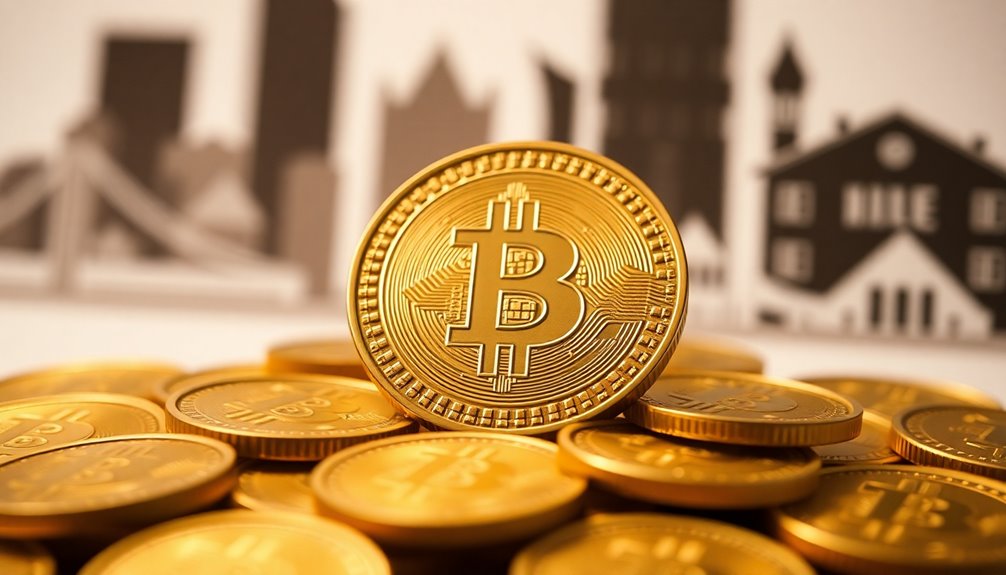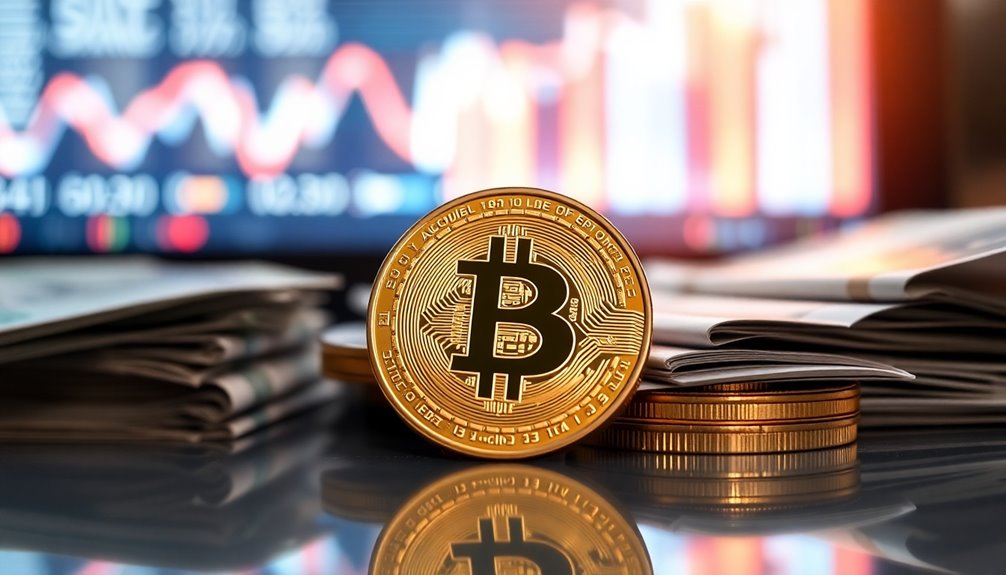Fungibility is the quality that lets you easily interchange assets, meaning each unit holds equal value and can replace another without loss. Think of money: a dollar bill can be swapped for another without any difference in worth. This interchangeability simplifies transactions and boosts market efficiency. While fungibility enhances liquidity, it can also lead to risks like counterfeiting and regulatory challenges. Understanding how market volatility can affect fungibility is crucial, especially for your investments. If you want to explore more aspects of fungibility and its implications for trading, keep going.
Key Takeaways
- Fungibility refers to the ability of assets to be easily exchanged or substituted without loss of value.
- Examples of fungible assets include currency and commodities, where each unit holds equal value.
- Increased fungibility enhances market liquidity and simplifies trading and exchange processes.
- Counterfeiting risks and regulatory challenges can complicate fungibility in asset transactions.
- Market volatility can impact fungibility by affecting asset values and investor behavior.
Concept of Interchangeable Assets

Fungibility serves as a cornerstone in the concept of interchangeable assets, where goods or assets can be easily swapped for one another.
When you deal with fungible assets, you'll notice that each unit is identical in specification. This means you can substitute one for another without any loss of value or quality.
For example, currencies like dollar bills are perfect fungible assets, as any bill of the same denomination holds the same worth. Commodities, such as No. 2 yellow corn, also follow this principle. Additionally, the principle of homogeneity ensures that all units possess the same characteristics and value, further enhancing their interchangeability.
The interchangeability simplifies trading, allowing you to divide assets into smaller units if needed. Recognizing these characteristics helps you understand the ease of trading fungible assets compared to their non-fungible counterparts.
Understanding Asset Interchangeability

When you think about asset interchangeability, it's essential to grasp how easily one asset can be replaced by another of the same type.
Fungible assets, like money or commodities, are perfect examples. Each $1 bill can be swapped for four quarters or ten dimes, illustrating their equal value. This mutual substitutability simplifies trading and exchange processes, making transactions smoother. Stocks, too, maintain their value regardless of where they're bought, showcasing fungibility in finance in finance.
However, not all assets share this characteristic; cars or diamonds can't simply be exchanged for one another due to their unique qualities. Understanding these distinctions is crucial, as fungibility directly impacts how efficiently assets can be traded in various markets.
Mechanism of Asset Exchange

The mechanism of asset exchange for fungible assets is straightforward and efficient, enabling seamless transactions. You can easily swap one unit for another without worrying about losing value. Each unit holds equal value, making them interchangeable and indistinguishable from one another. This uniformity simplifies the trade process, allowing for direct exchanges without complications. You might also take advantage of arbitrage opportunities, which arise from price differences across various platforms. Additionally, fungibility enhances market efficiency by increasing liquidity and reducing transaction costs. Since these assets can be divided into smaller units, you can trade them separately, further streamlining the exchange process. Moreover, understanding the characteristics of exchange assets is essential for recognizing how fungibility plays a role in various asset transactions.
Pros and Cons of Fungibility

While fungibility offers numerous advantages, it also comes with its share of drawbacks that can impact both individual investors and the broader market.
One major concern is the risk of counterfeiting, as indistinguishable assets can lead to significant value loss. You'll need stringent security measures to protect against this threat, which can complicate trading. Additionally, the importance of fungibility in facilitating trade means that any disruptions can have far-reaching consequences in market efficiency.
Furthermore, regulatory challenges can arise, especially in cross-border transactions, making compliance a headache. Different regulations can affect how fungible assets operate, requiring coordination among various regulatory bodies.
Despite these challenges, the benefits of fungibility—like increased market liquidity and simplified transactions—often outweigh the drawbacks, but it's essential to stay aware of these risks as you navigate the market.
Asset Equivalence Evaluation

Understanding fungibility not only reveals its benefits and drawbacks but also highlights the importance of asset equivalence evaluation.
When you assess fungible assets, you recognize their interchangeable nature, simplifying trades and exchanges. Since these assets, like cash or stocks, share the same value and characteristics, evaluating their equivalence becomes straightforward. This evaluation aids in maintaining liquidity within financial markets, enabling quicker transactions and fostering market efficiency. For instance, investors often consider the role of gold IRAs in diversifying their portfolios, as they offer a unique form of asset that can retain value. Whether you're dealing with commodities or cryptocurrencies, knowing that each unit holds the same value allows you to make informed decisions. Additionally, the ability to compare assets through valuation metrics enhances the understanding of their relative value in the market.
Market Volatility Impacts Fungibility

Market volatility significantly affects fungibility, particularly in environments where economic conditions are unstable. In emerging markets like Zimbabwe, the fungibility of shares can lead to exchange rate volatility.
When investors shift from bearish to bullish markets, they often convert their local currency into foreign currencies, causing local currency depreciation. This relationship is supported by the Portfolio Balance Approach, emphasizing how these market movements impact exchange rates. Moreover, fungibility influences how exchange rate fluctuations affect stock prices.
Additionally, fungibility enhances market liquidity, allowing for easier asset interchange, which improves trading experiences. As fungibility increases, transaction costs decrease, and market efficiency rises, attracting more buyers and sellers.
Understanding these dynamics is crucial for navigating volatile markets and making informed investment decisions.
Digital Currencies Gaining Traction

As financial landscapes evolve, digital currencies are gaining traction and reshaping traditional notions of fungibility. Their interchangeability means that each unit, like Bitcoin, holds the same value, making transactions smooth and efficient. This uniformity ensures every unit is treated equally, simplifying buying and selling. Additionally, fungibility is crucial for seamless transactions on blockchain networks, providing a reliable foundation for digital currency exchanges.
Furthermore, digital currencies are highly divisible, allowing you to make transactions in fractional amounts, which is essential for diverse purchasing needs. The decentralized nature of blockchain technology enhances the security and transparency of these transactions. However, be aware that regulatory actions can impact fungibility, as certain coins may lose value or face restrictions. Privacy features also play a role, as ongoing efforts to enhance anonymity aim to preserve fungibility amidst scrutiny. Embracing digital currencies offers a new perspective on value and exchange in today's economy.
Diversify Asset Types Strategically

Diversifying your asset types strategically is essential for building a resilient investment portfolio. You should consider a mix of stocks, bonds, real estate, and funds. Stocks can provide high returns but come with volatility, so invest across different sectors. Bonds offer steady income, and diversifying within various bond types can help manage interest rate risks. Additionally, spreading investments across various asset classes minimizes risk exposure and reduces reliance on a single investment's performance.
Real estate can appreciate and generate income, but look into REITs for easier access. Including precious metals in your portfolio can also enhance its resilience against market fluctuations. Funds, like mutual and index funds, already provide diversification. Lastly, include stable options like CDs and savings accounts to cushion against market fluctuations. By spreading investments across these asset classes, you reduce risk and enhance potential returns, creating a balanced and robust portfolio.
Frequently Asked Questions
How Does Fungibility Affect Everyday Transactions?
Fungibility impacts your everyday transactions by simplifying how you exchange assets.
When you use cash, for example, you can easily trade a $10 bill for two $5 bills without losing value. This interchangeability speeds up purchases and sales, making your shopping experience smoother.
It also ensures that you can quickly convert assets like stocks or commodities, enhancing liquidity and allowing you to react swiftly to market changes when needed.
Are All Assets Fungible?
Imagine holding a crisp dollar bill in your hand, knowing you could trade it for a coffee or a newspaper without a second thought.
Not all assets share this quality. Some, like a family heirloom or a rare baseball card, carry unique stories and values that make them irreplaceable.
While many assets can be swapped easily, others stand apart, each with their own distinct worth.
What Are Examples of Non-Fungible Assets?
When you think about non-fungible assets, consider unique items like rare artworks or limited edition collectibles.
A diamond ring with specific features or a vintage car can't be exchanged for something identical.
Digital assets also fall into this category, such as unique digital art or in-game items.
Even real estate properties are non-fungible, as each has its own unique location and characteristics that set them apart from one another.
Can Fungibility Change Over Time?
Yes, fungibility can definitely change over time.
You might notice that technological advancements or shifts in market conditions can impact how easily assets can be exchanged. For instance, improvements in storage technology can make renewable energy sources more fungible.
Additionally, changes in regulations or economic factors can influence the interchangeability of commodities, affecting their overall value and usability.
How Does Regulation Impact Asset Fungibility?
Imagine a world where currency loses value overnight, much like a sinking ship.
Regulation plays a crucial role in ensuring that assets remain interchangeable and equal in value. It creates standards that prevent counterfeiting, enforces compliance, and maintains liquidity in markets.
By regulating assets like cryptocurrencies and environmental credits, authorities ensure that you can trade them seamlessly, without worrying about differences that could affect their worth.
These rules protect your investments and maintain market integrity.
Conclusion
In the world of finance, understanding fungibility can unlock new opportunities for you. Imagine being able to trade assets seamlessly, knowing each one holds equal value. But what if market volatility disrupts this balance? As digital currencies rise, the landscape of fungibility is shifting. You may find yourself at a crossroads, deciding how to diversify your assets strategically. Will you take the leap and embrace these changes, or will you let hesitation hold you back? The choice is yours.









